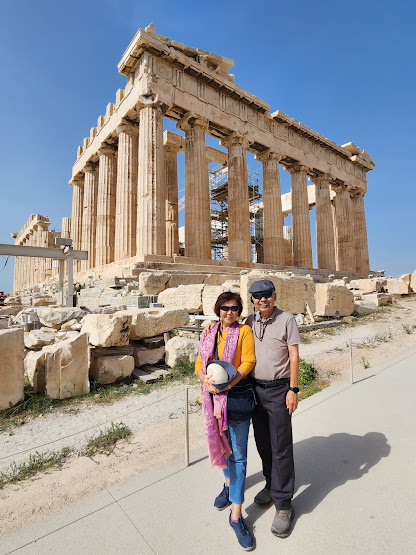After breakfast at Mitsis Galini Wellness Spa & Resort, we checked out from the hotel and travelled 120Km to arrive at Acropolis in Athens.
The first reference to Athens in the Bible is found in Acts 17:15 - when Apostle Paul was brought to Athens during his second missionary journey. That's around AD 50. At that time, Athens was known for its intellectual and philosophical traditions. The city was filled with statues, temples and altars dedicated to the Greek gods. Paul was at Areopagus (Mars Hill) and Acropolis was within view. There is no evidence to show that Paul had visited the Acropolis.
 |
| Google aerial view of the Acropolis. |
In the 5th century BC, Athens emerged as a powerful city-state following the Persian Wars. Acropolis was transformed into a monumental center of art and architecture. The Parthenon, the Erechtheion, the Temple of Athena Nike and the Propylaea gateway were constructed. These structures were dedicated to goddess Athena as a celebration of Athenian power.
.jpg) |
| Front of amphitheater. |
 |
| Amphitheater. |
****************************************************
****************************************************
The Erechtheion.
The Erechtheion is the temple dedicated to both Athena and Poseidon. Athena is the Greek goddess of wisdom, war and craftsmanship. She is often depicted with a helmet, shield and is accompanied by an owl symbolizing wisdom. Poseidon is the god of the sea, earthquakes, storms and horses in ancient Greek mythology. He is the brother of Zeus, the king of the gods and Hades, the god of the underworld.
Temple of Athena Nike.
When we were at the Erechtheion, the local tour guide was keen to tell us the story of an olive tree planted there. The tree was believed to be a direct descendant of the one planted by Athena. Story has it that when the Persians burned Athens in 480 BC, the olive tree was destroyed but miraculously sprouted new shoots the next day. To the people, this symbolized resilience and renewal.
The olive tree became a lasting symbol of peace, prosperity and wisdom, qualities associated with Athena herself. Olive branches and wreaths were symbols of victory in ancient Greece, making them important in various rituals and ceremonies, including the Olympic Games.
It's indeed remarkable that the olive tree, the only tree found there is growing well under such dry and arid condition.
***************************************************
The Parthenon.
The Parthenon built in the 5th century BC originally served as a temple dedicated to the goddess Athena.
When Christianity was spread through the Roman Empire, the Parthenon was converted into a Christian center dedicated to Virgin Mary. This lasted from 6th to 15th centuries.
During the Ottoman occupation of Greece (1460s - 1687), the Parthenon was converted into a mosque. A minaret was added.
The Acropolis is now a UNESCO World heritage Site. Restoration and preservation efforts are continuing even at our time of visit.
 |
| On-going restoration work. |








.jpg)






No comments:
Post a Comment